The Reed Flute Cave was something I was really looking forward to in Guilin. It is a natural limestone cave, and a world heritage listed area, with multicolored lighting all through it. According to Sue, our guide, it has been one of Guilin’s best kept secrets and local never told outsiders about the cave until the 60s. But according to everyting I’ve read on the internet, it has been one of and has been one of Guilin’s most interesting attractions for ages and has been attracting visitors for over 1200 years – inside, there are supposed to be more than 70 inscriptions written in ink, which can be dated back as far as 792 AD in the Tang Dynasty and these aged inscriptions are supposed to be evidence of its long standing history as an attraction in Guilin ever since. But Sue didn’t mention them, and the cave formations are remarkably well presereved if it has been having visitors for over a millenia.
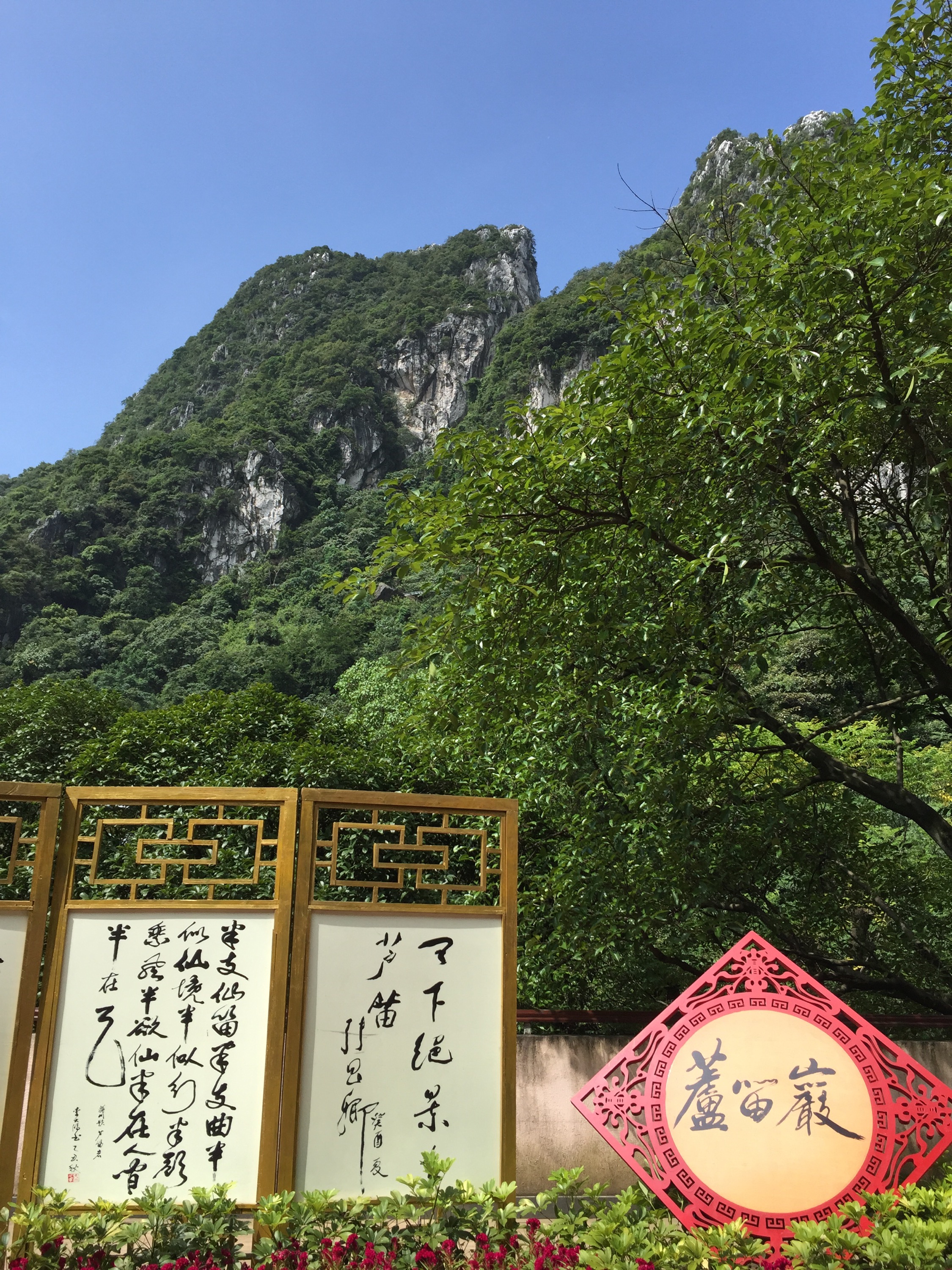
 Anyway, the cave itself is over 180 million years old and formed in the same way limestone caves the world over are formed -harder rock, softer rock, water seeping through, limestone hanging onto the ceiling, limestone crowing up from the floor, columns grow… 20cms every 100 years and, Ta-da! Pretty cave. This cave got its name from the type of reed that used to grow outside the primarly entrance, which was used to made melodious local flute instruments. The Reed Flute Cave is filled with a large number of stalactites, stalagmites and large rock formations in weird and wonderful shapes – lions, owls, christmas trees, veggie cardes, and all sorts of things. The cave is much like many other limestone caves that I’ve visited, only the multicolored lightning artificially illuminates the cave and makes it look really rainbow coloured ‘ooh, aah, pretty’.
Anyway, the cave itself is over 180 million years old and formed in the same way limestone caves the world over are formed -harder rock, softer rock, water seeping through, limestone hanging onto the ceiling, limestone crowing up from the floor, columns grow… 20cms every 100 years and, Ta-da! Pretty cave. This cave got its name from the type of reed that used to grow outside the primarly entrance, which was used to made melodious local flute instruments. The Reed Flute Cave is filled with a large number of stalactites, stalagmites and large rock formations in weird and wonderful shapes – lions, owls, christmas trees, veggie cardes, and all sorts of things. The cave is much like many other limestone caves that I’ve visited, only the multicolored lightning artificially illuminates the cave and makes it look really rainbow coloured ‘ooh, aah, pretty’.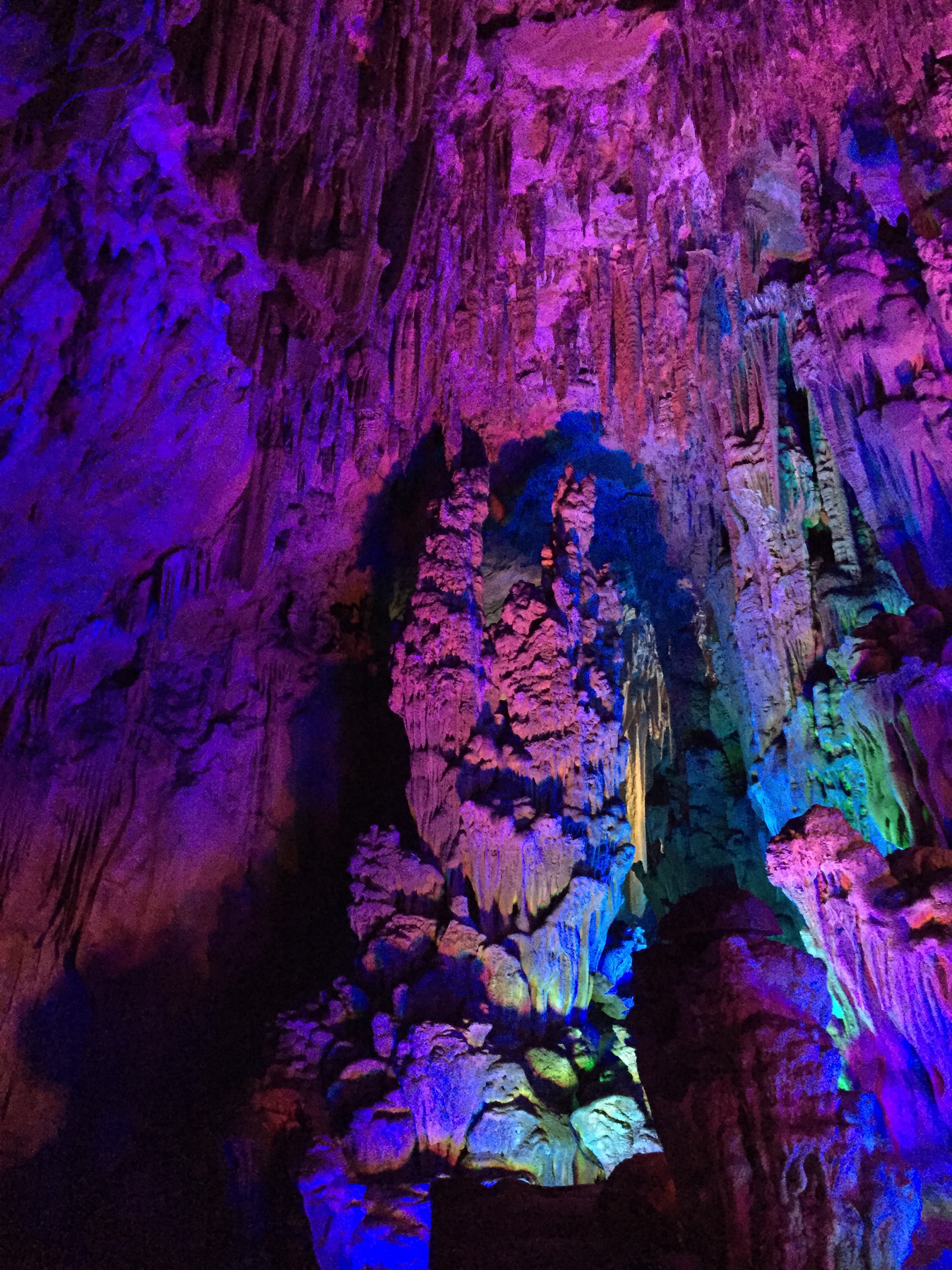
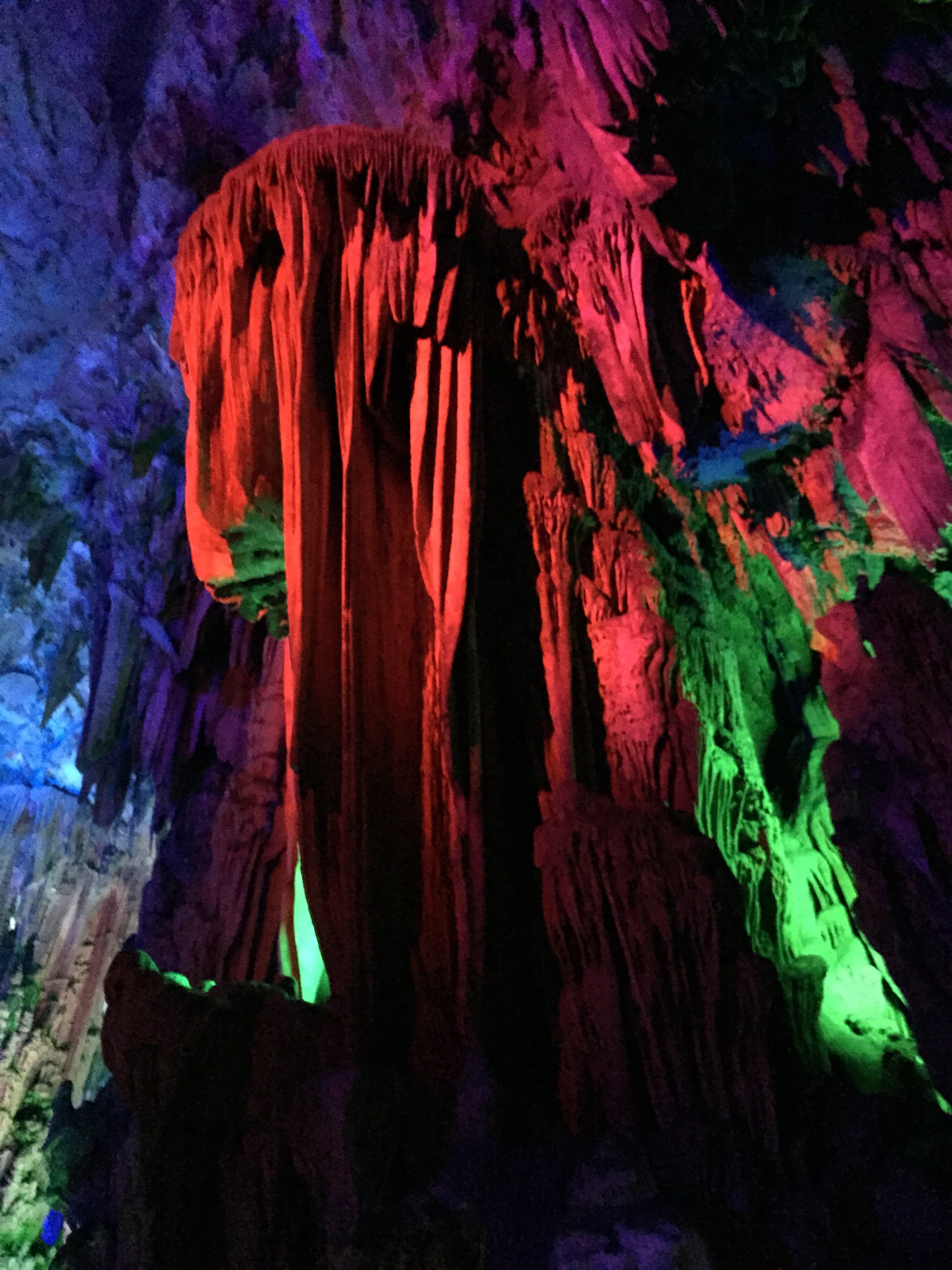

The Christmas tree: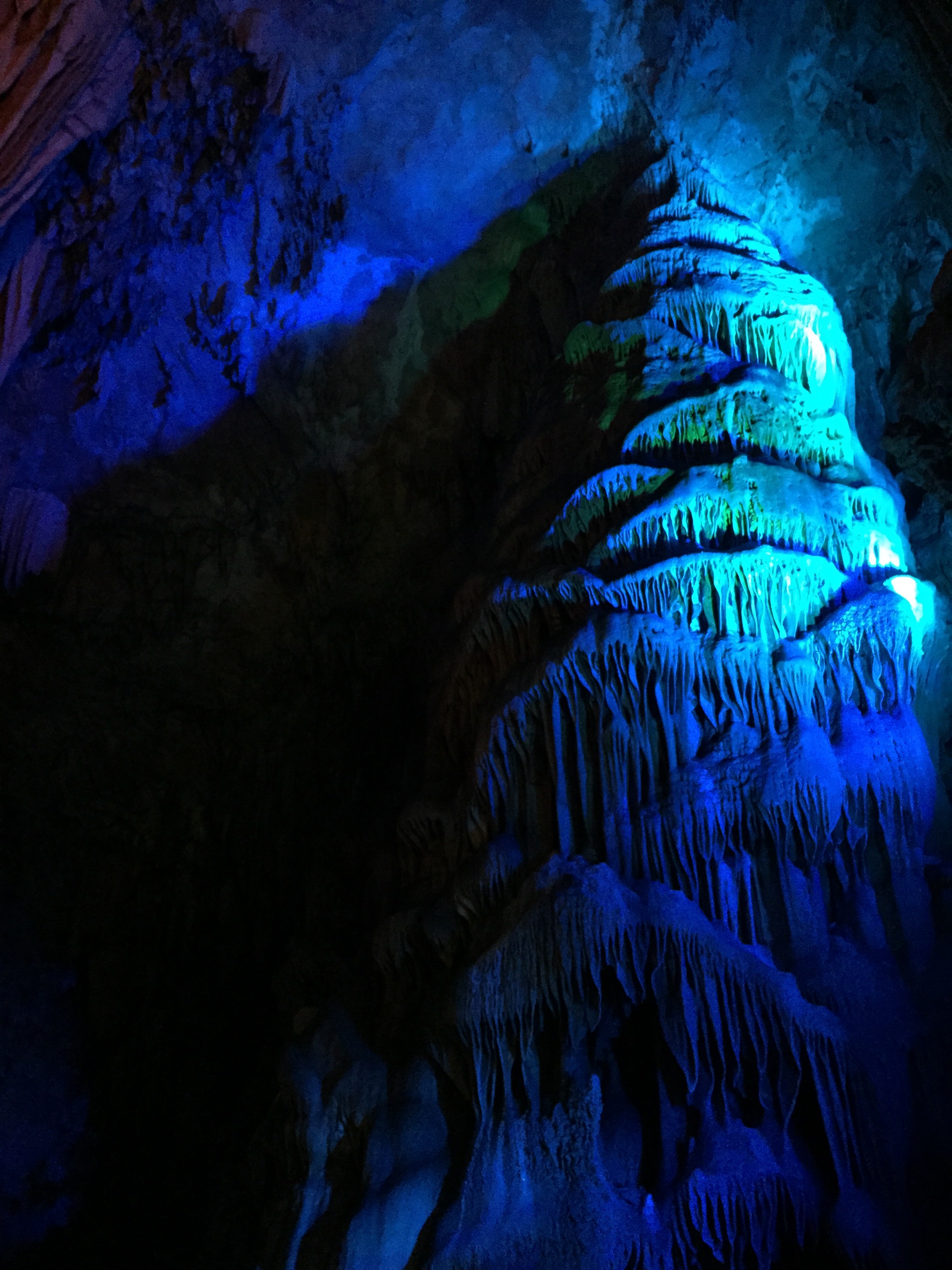 The fruiit and veggie patch- beans, peanuts, string beans, broccoli etc.
The fruiit and veggie patch- beans, peanuts, string beans, broccoli etc. 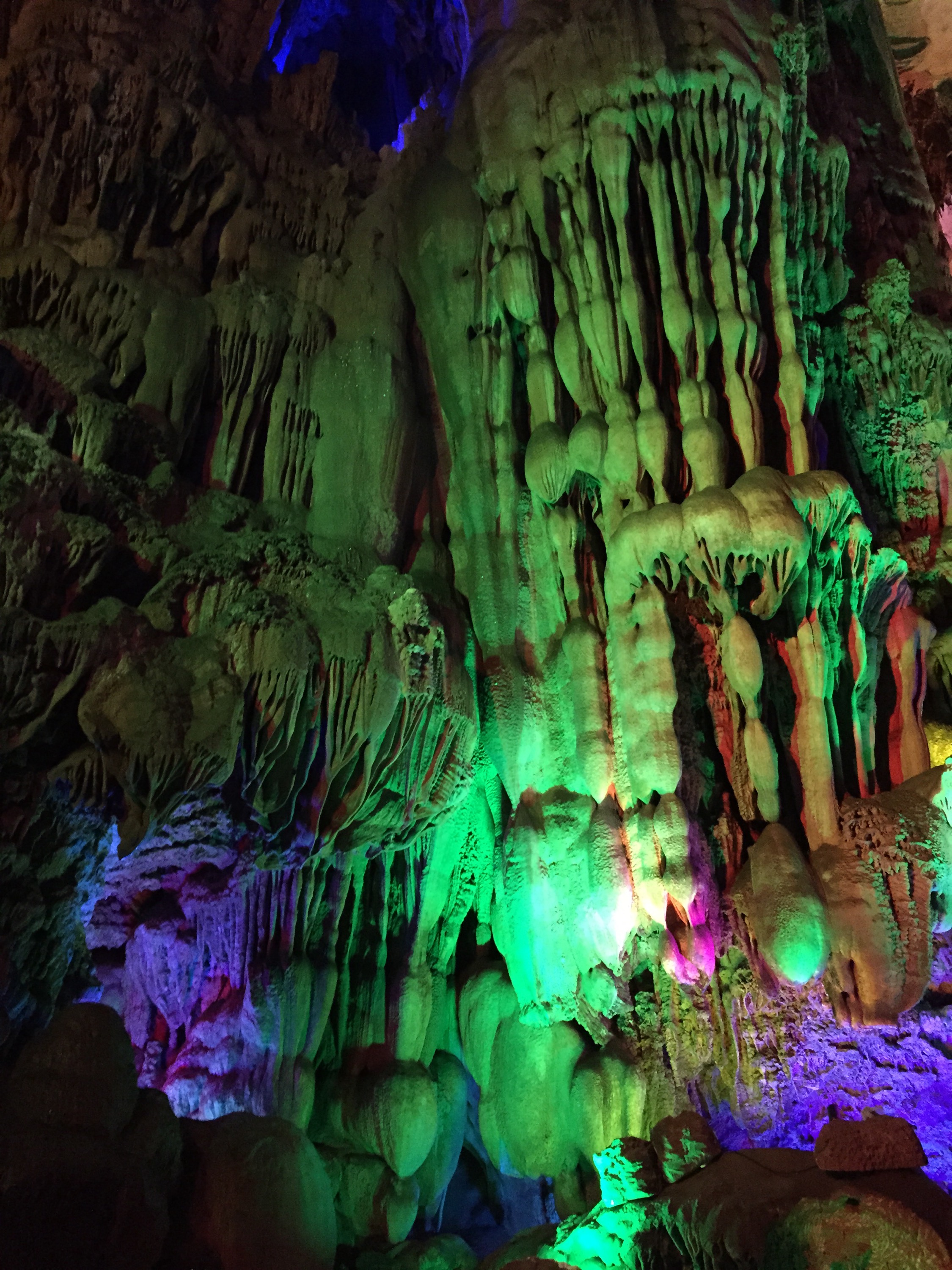
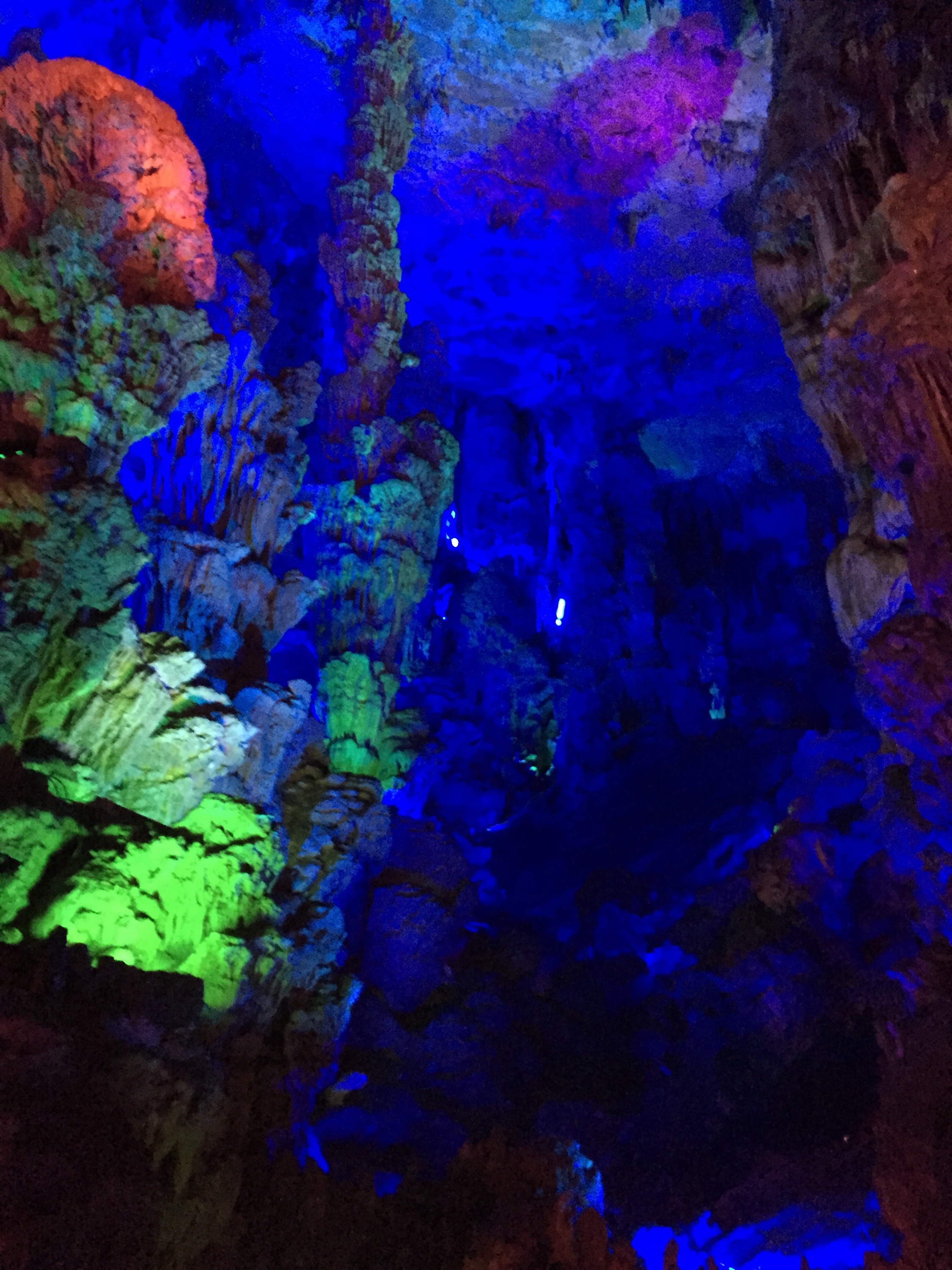 The two towers – amost joined up:
The two towers – amost joined up:


This section is believed to be a cityscape of Guilin: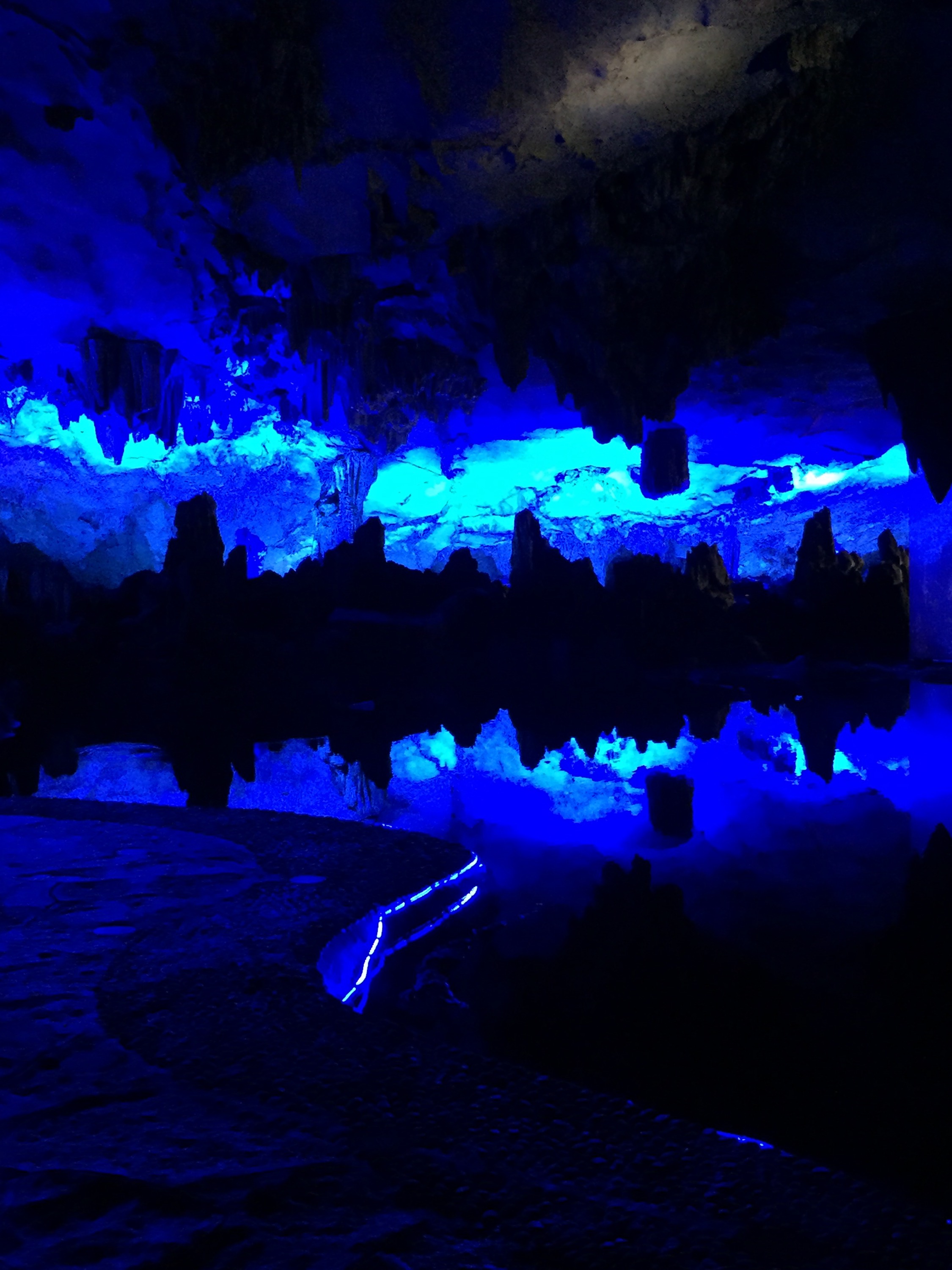 I thought this section of the cave was really pretty – it is is about 18m high and about 30m across, so it is a large cavern, so the management of the cave, felt for some reason this is a great place to put on a show. The show consisted of a video projected onto the roof ceiling of the cave in the one flat spot available, and then a projection of two people doing ballet to Swan Lake beside the pond in the above picture. Bizarre. The cave is quite interesting enough, but for some reason the Chinese have decided to add value to the ticket entrance with these strange ‘shows’.
I thought this section of the cave was really pretty – it is is about 18m high and about 30m across, so it is a large cavern, so the management of the cave, felt for some reason this is a great place to put on a show. The show consisted of a video projected onto the roof ceiling of the cave in the one flat spot available, and then a projection of two people doing ballet to Swan Lake beside the pond in the above picture. Bizarre. The cave is quite interesting enough, but for some reason the Chinese have decided to add value to the ticket entrance with these strange ‘shows’.
The ‘chandelier’ of the largest cavern known as the Crystal Palace: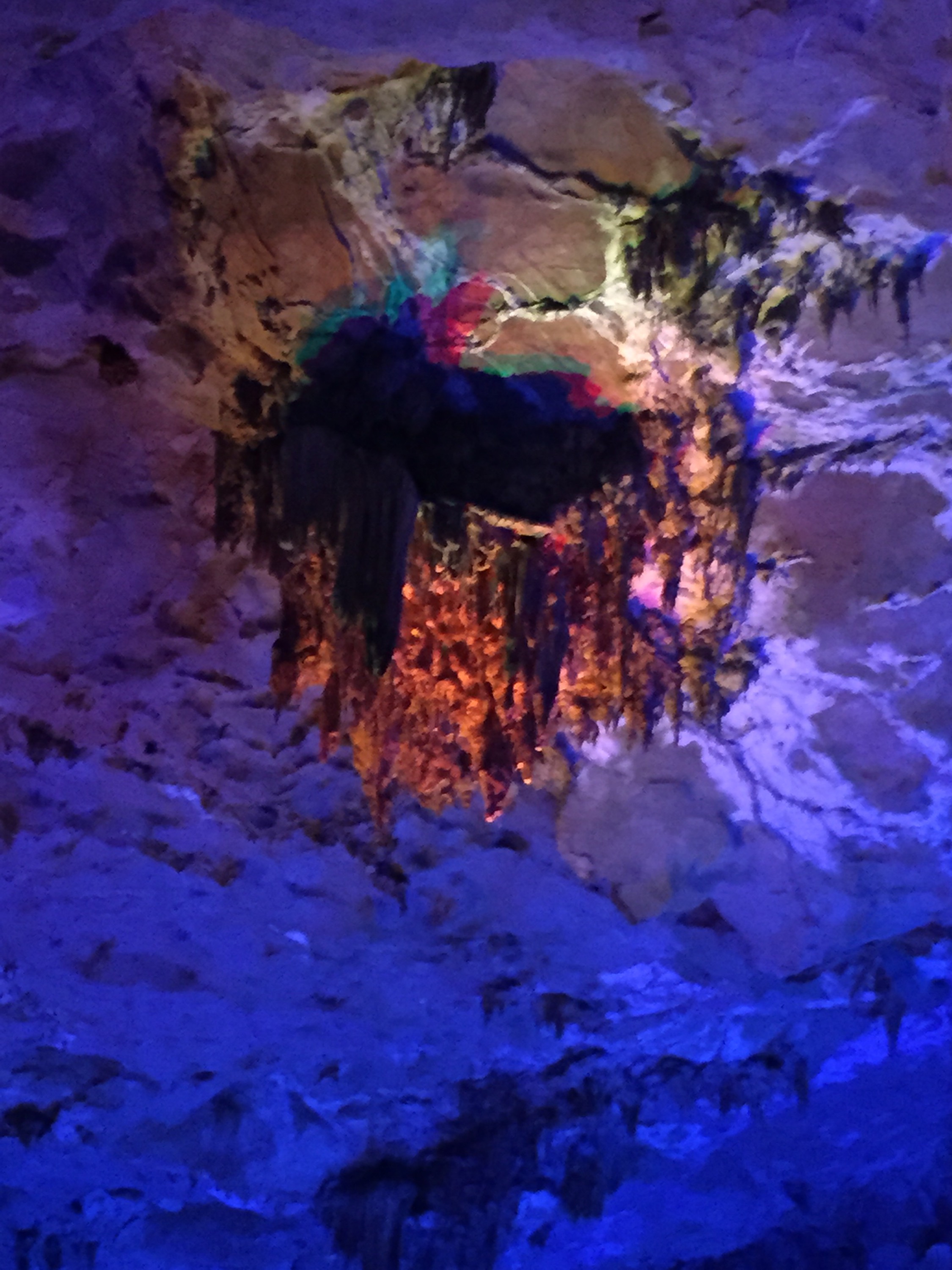
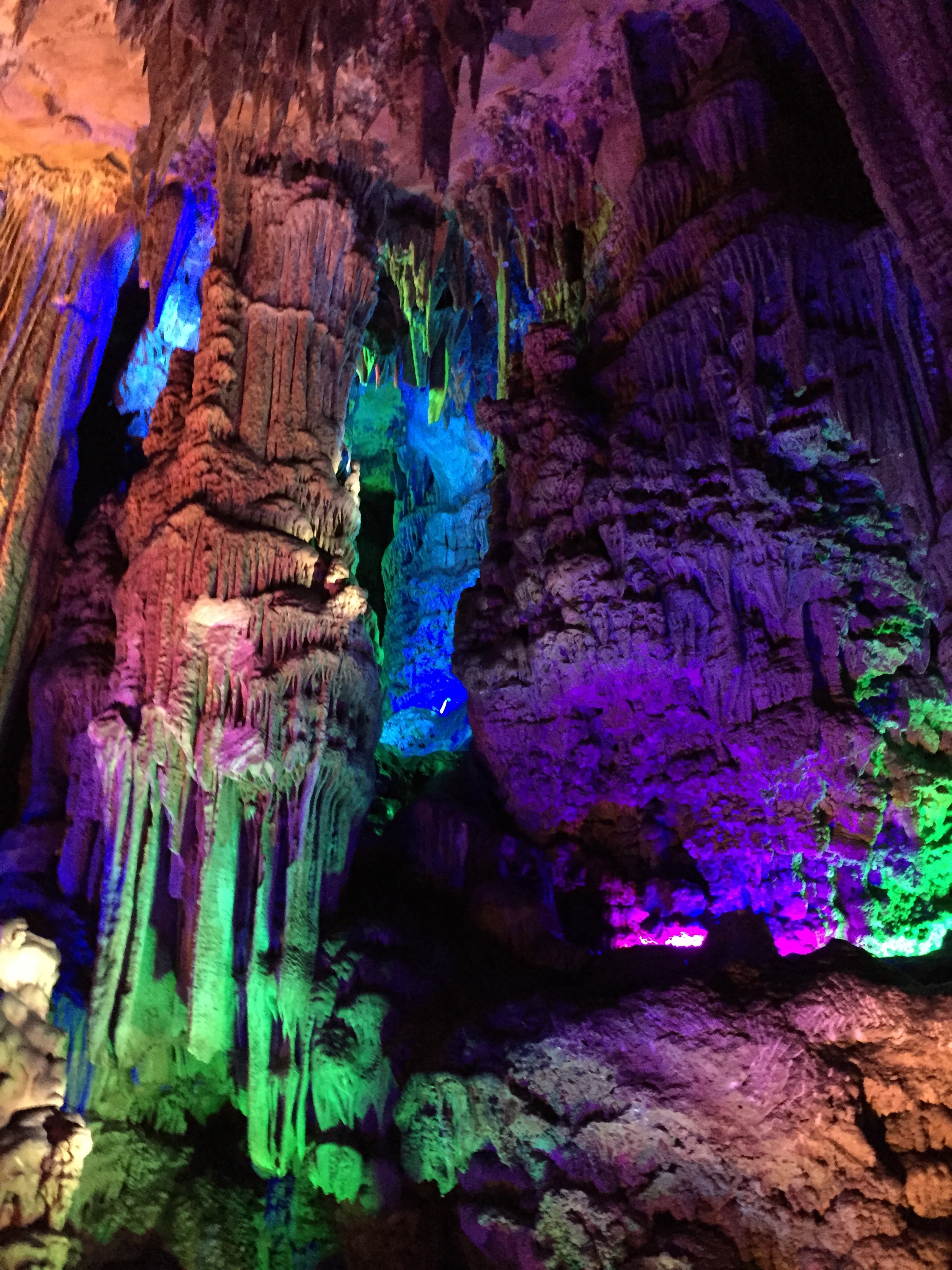
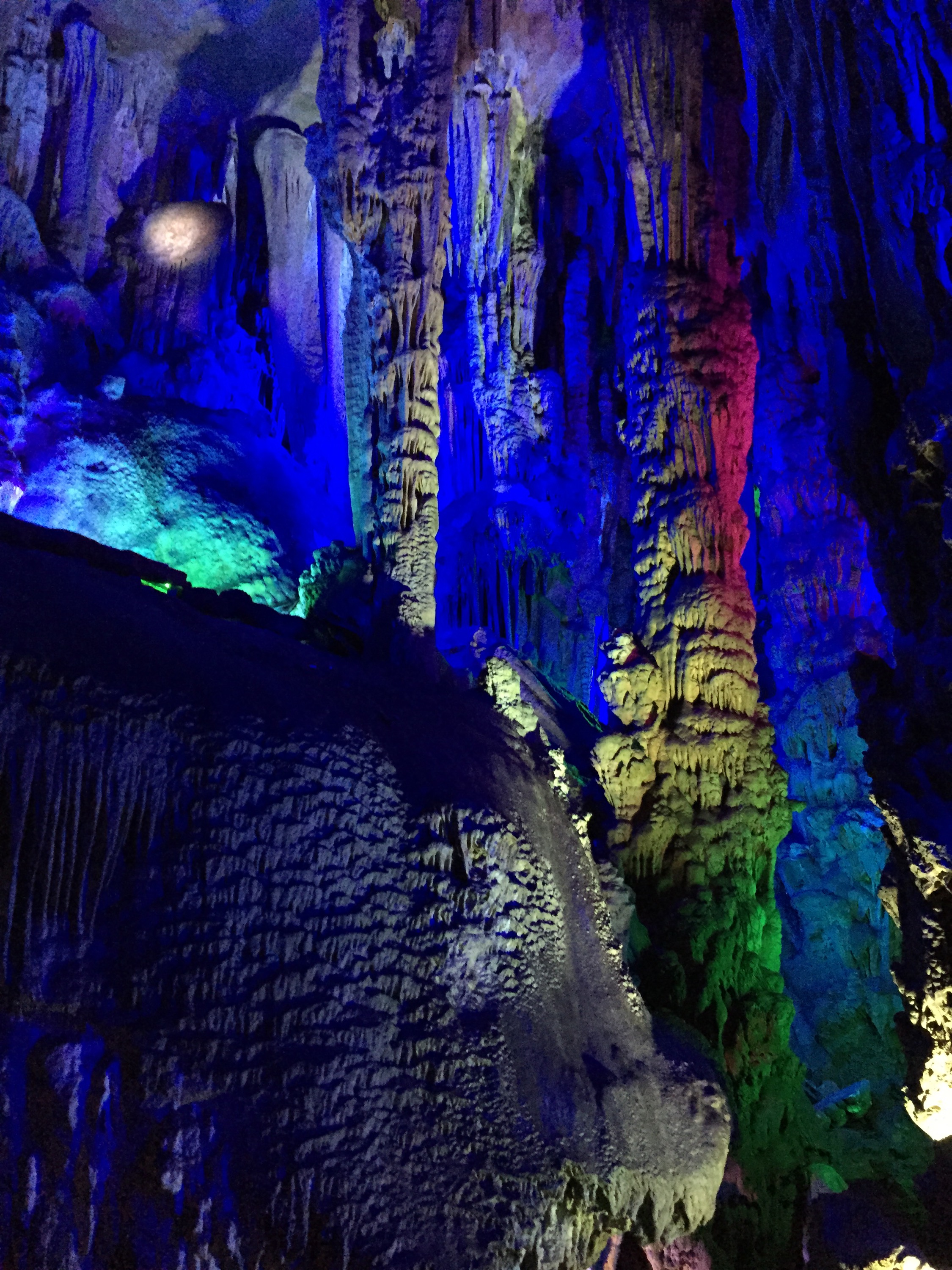
A lion: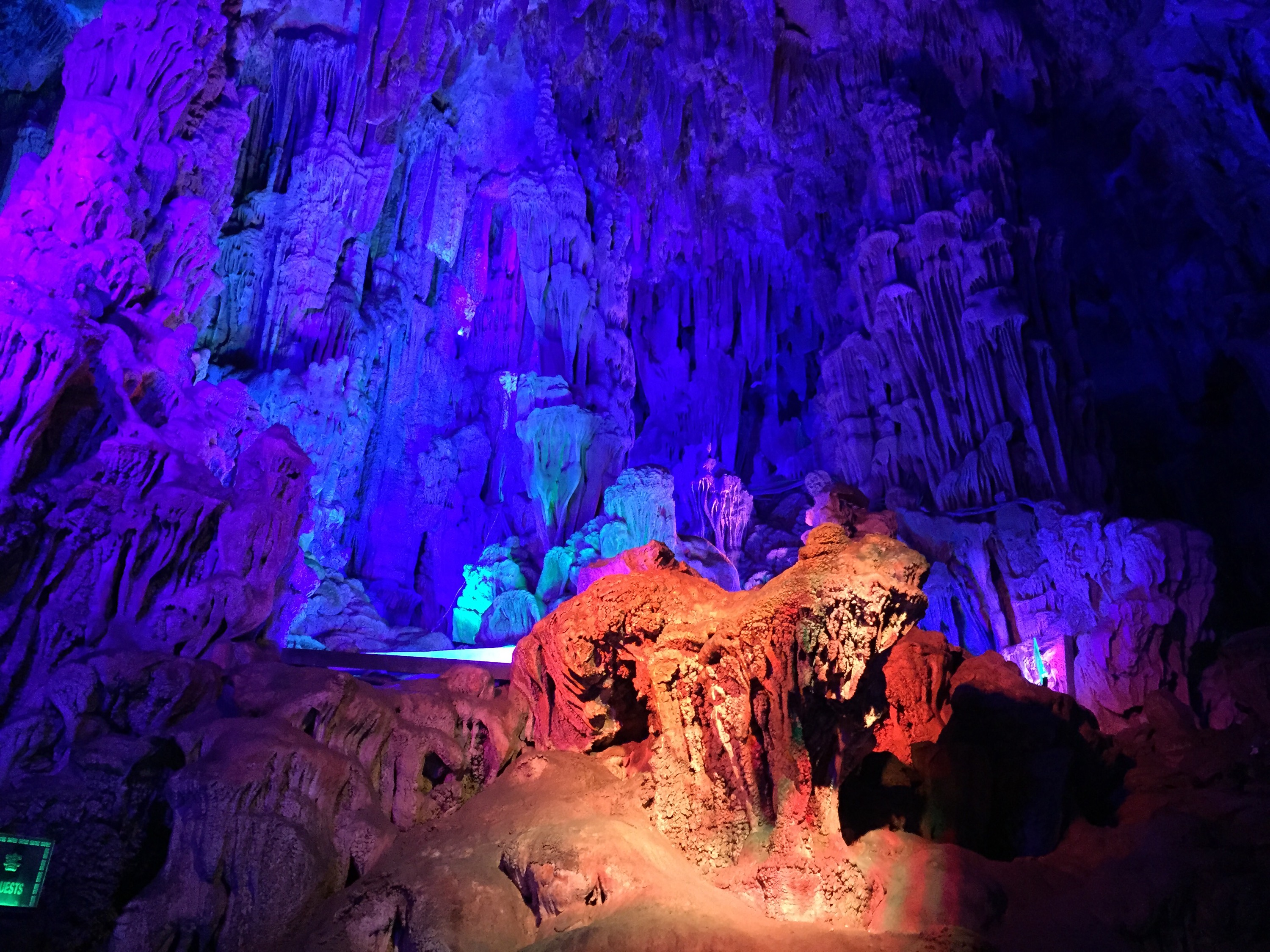
As far as we could see the only thing living down in the cave were tiny bats that kept flapping around. Very cute. It was also lovely and cool down underground – around 20 to 22C, which was much preferred to the 35C and 75% humidity up top.
After the lovely cool of the caves we ventured back out into the heat to visit nearby Elephant Hill. Guilin is a city of only 700,000 people (only!) so it is a lot less hectic and easier to get around. Far fewer tourists and far less crush – though we have discovered that in an enclosed space like the caves, one Chinese family of three on holiday can make as much noise as an entire air craft’s passenger manifest. O.o
Nest stop – Elephant Trunk Hill, which is considered the main symbol of the city of Guilin. The small mountain got its name because it looks like an elephant drinking water. As the legend would have it the Jade Emperor came down from Heaven with the elephant and the poor elephant got sick. When the Jade Emperor went back to Heaven, he left the sick elephant behind. The people of the area nursed the poor elephant back to health and when he was well, he decided he wanted to stay – but the Jade Emperor wanted him to come back to Heaven, so he sent troops to come and bring the elephant back. The elephant fought the Emperor’s troops for seven days and seven nights and then one of the Generals from the Emporer’s troops stabbed him in the back with a sword while he was drinking from the LIjang River. The elephant died, but did not fall over, and now there is a pagoda named, Sword Hilt Pagoda up high on the elephant’s back and the elephant stays here on earth forever.
The round opening under the elephant’s trunk is known as Water-Moon Cave – at night the reflection of the moon can be seen through the arch and it looks as if it is under the water and floating on the surface of the water at the same time. 

 We also happend to see this woman fishing with her cormorants. I have seen many documentaries on China showing how efficient the cormorants are at catching fish, but it was lovely to see them here. The cormorants are pretty much domesticated birds, not like the shags we have back home, and they have been hand raised, have clipped wings so they can not fly off, and when they are fishing, they have a string around their throat so they can not swallow the fish they catch. Only once their work is done, do their owners feed them.
We also happend to see this woman fishing with her cormorants. I have seen many documentaries on China showing how efficient the cormorants are at catching fish, but it was lovely to see them here. The cormorants are pretty much domesticated birds, not like the shags we have back home, and they have been hand raised, have clipped wings so they can not fly off, and when they are fishing, they have a string around their throat so they can not swallow the fish they catch. Only once their work is done, do their owners feed them.

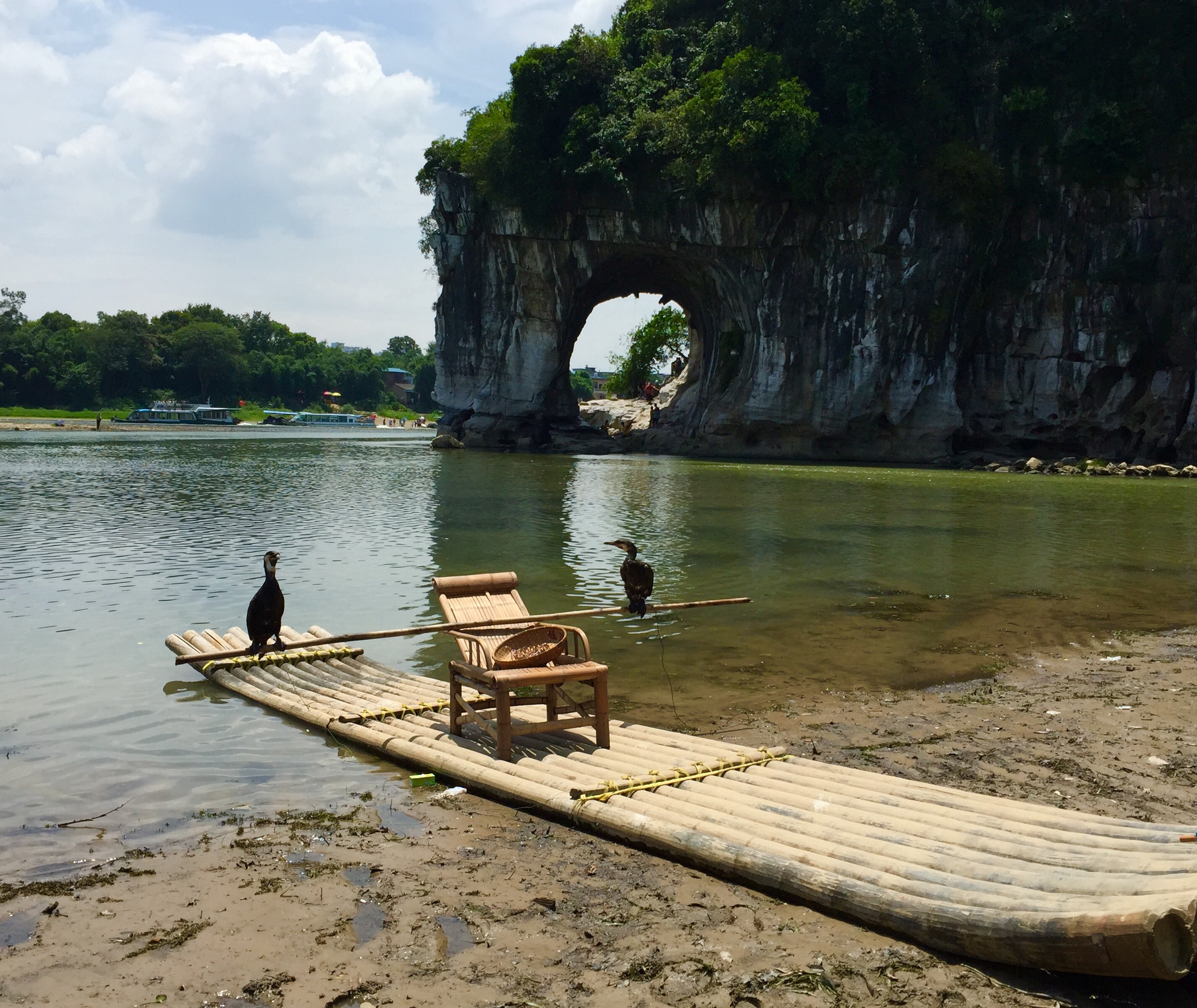
This stone is on Lover’s Island. Near to Elephant Trunk Hill is the questionably romantic place of Lover’s Island where couples like to meet up for courting. The little island itself was quite quaint. It was lined by floating restaurants selling mostly meat-on-a-stick, and lots of lovely shady spots to hang out…

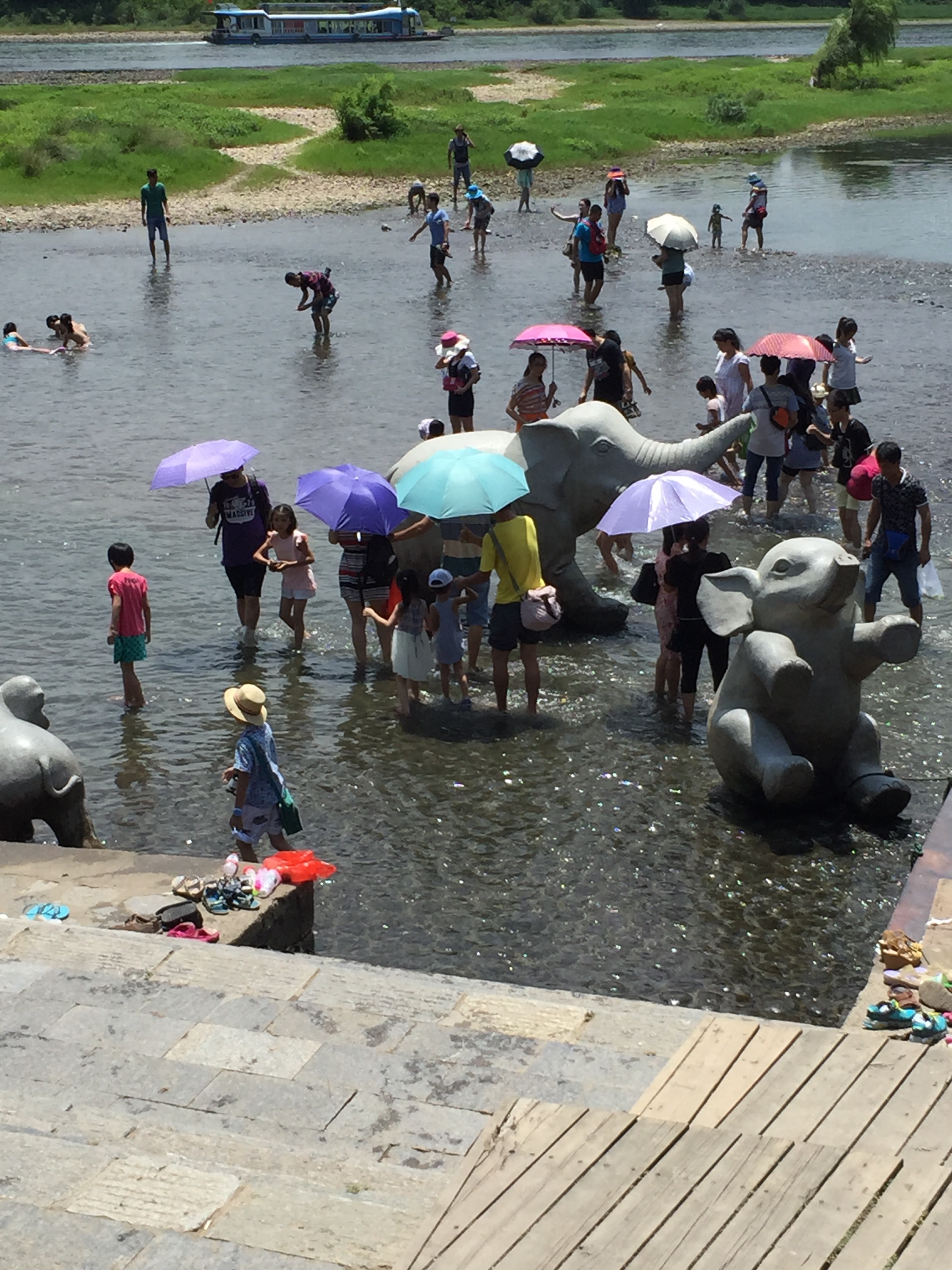
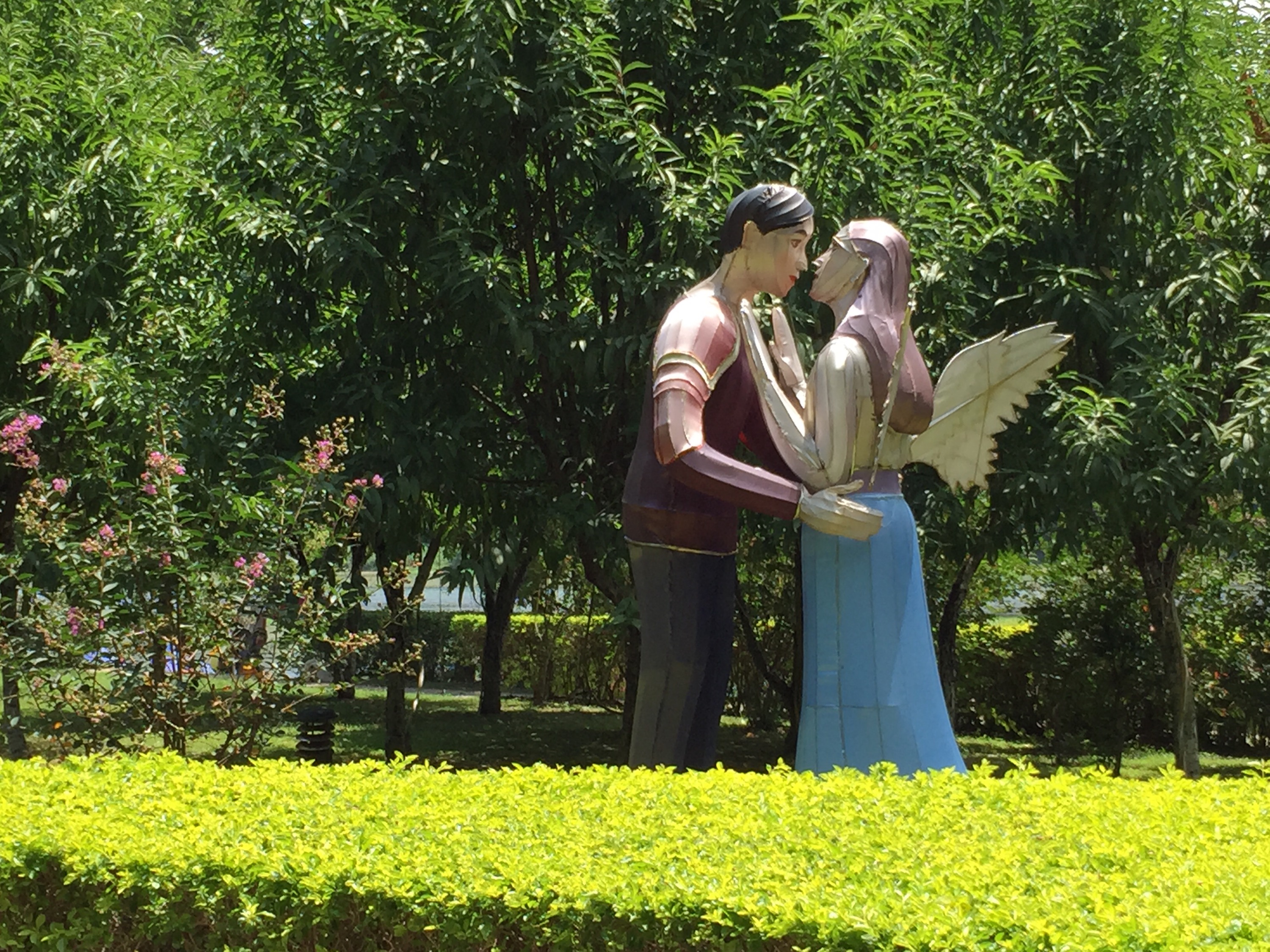

…but it was also full of these complete weird, and not a little bit tacky sculptures that apparently light up at night. Perhaps this was another weird example of ‘value adding’, as the park is not free to enter during the day time. But it is at night and early morning for locals only. Anyway, it is full of ‘famous couples’ – Romeo and Juliet, Adam and Eve, Mickey and Minnie Mouses, Donald and Daisy, Rose and Jack from the Titanic! 😀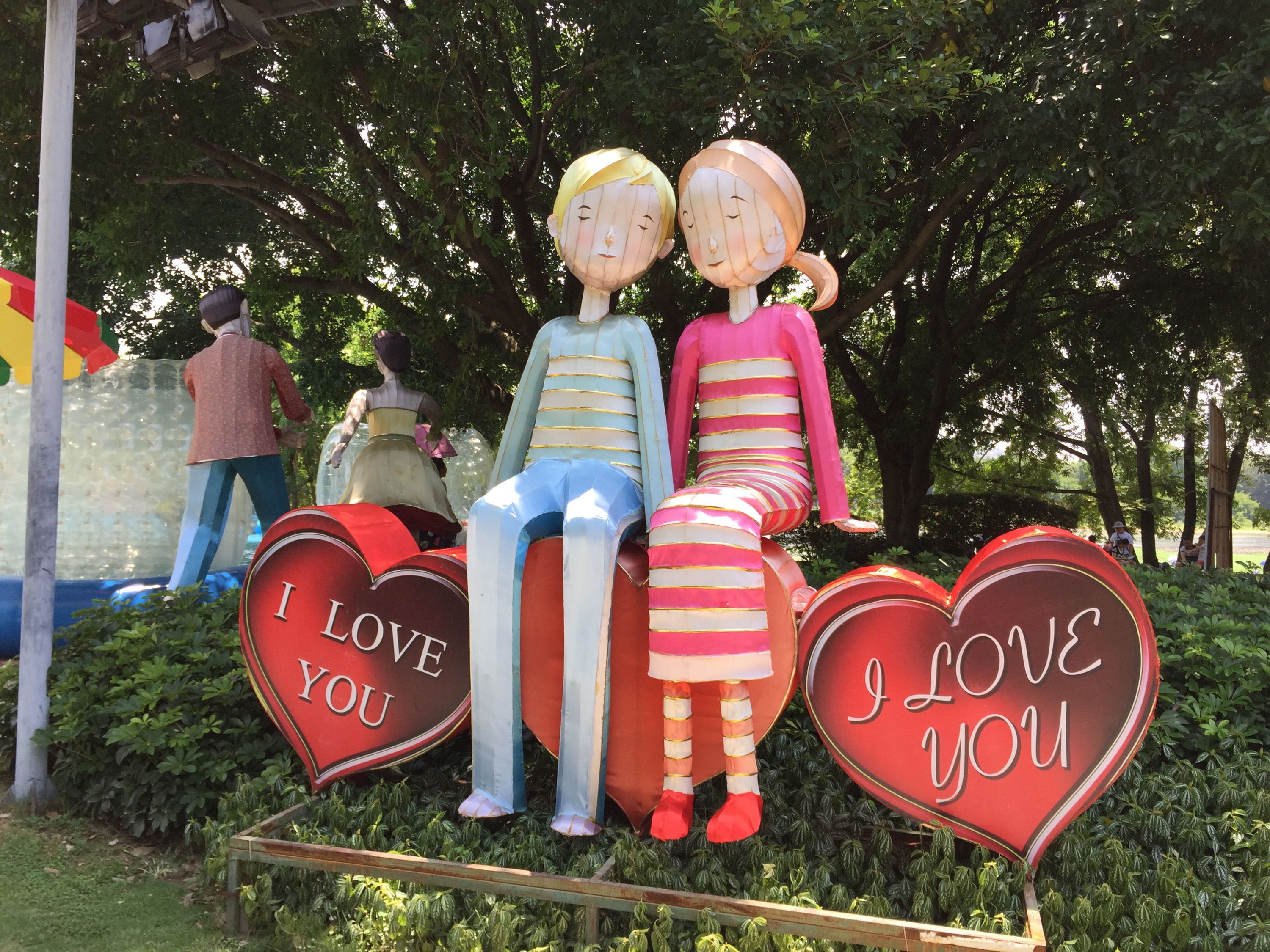

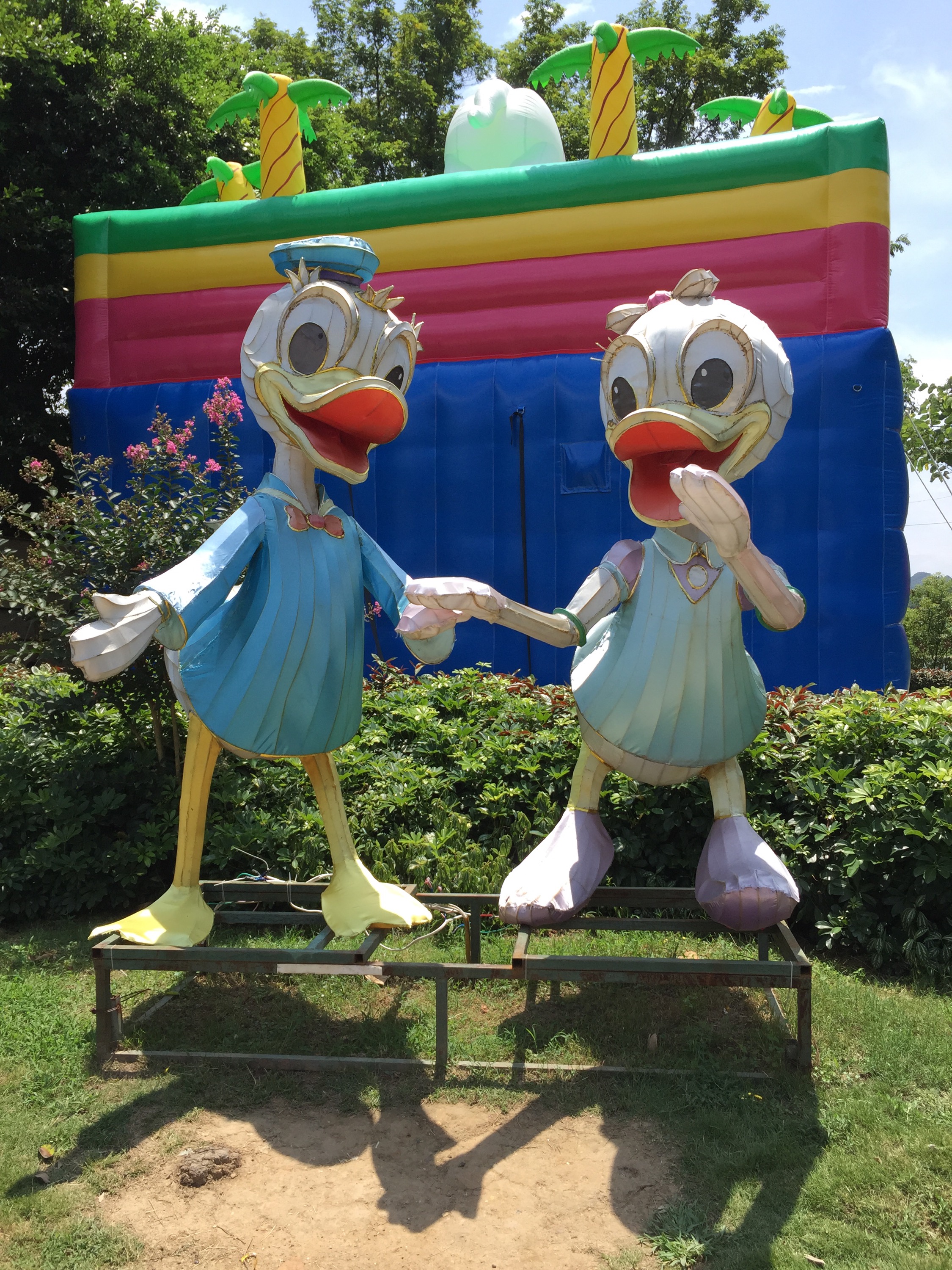
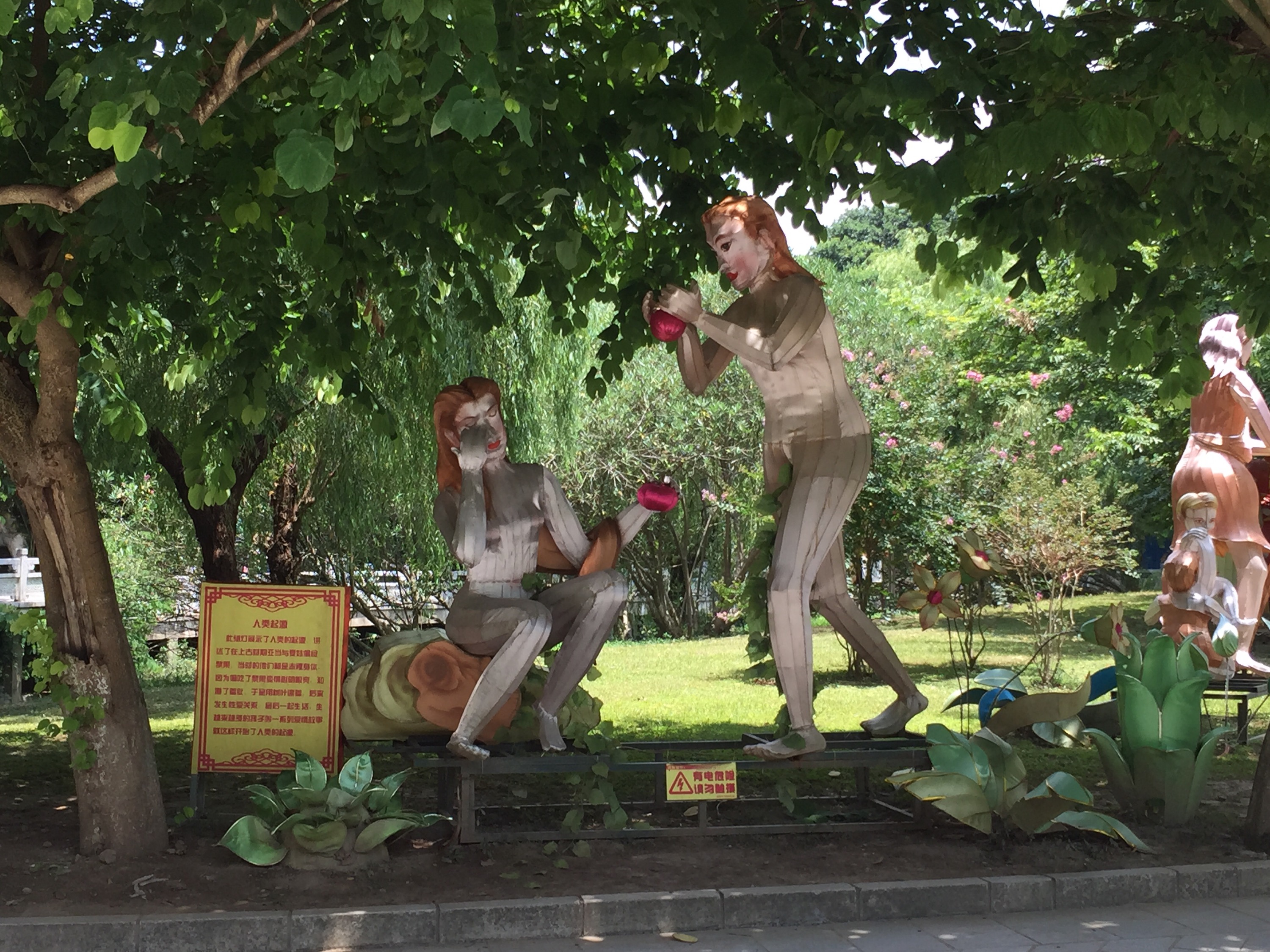
Next we made our way to Seven Start Park. Which at first was a little confusing, as the locals here tend to give the toilet facilities ‘star ratings’… “This one only 2 star Happy Room, not very good. 4 star Happy Room just around next stop in Palace”. So we were expecting a park with excellent bathroom facilities!! 😛 The Seven Star Park is lined up from the air with the seven star shape of the Big Dipper, and it is a truly impressive public garden. There are lots of lovely open spaces, ponds, a zoo, amusements, wide open spaces for public events and another small cave system.
The Seven Star Park is lined up from the air with the seven star shape of the Big Dipper, and it is a truly impressive public garden. There are lots of lovely open spaces, ponds, a zoo, amusements, wide open spaces for public events and another small cave system.
I became enamoured of this 1997 sculpture that was designed to mark the occasion of Hong Kong coming back under Chinese rule. It depicts many famous things in Chinese history. China and the birth through the mountains 5000 years ago, and the building of canals:
China and the birth through the mountains 5000 years ago, and the building of canals:
 A depiction of the one artefact that carbon dates China’s history to 7000 years – the large pottery trough with the pig motif on it. It also shows on this panel, the use of water wheels to move things and generate energy to save labour.
A depiction of the one artefact that carbon dates China’s history to 7000 years – the large pottery trough with the pig motif on it. It also shows on this panel, the use of water wheels to move things and generate energy to save labour.  Traders from the West, and the use of water wheels to lift heavy objects in construction and bridge building:
Traders from the West, and the use of water wheels to lift heavy objects in construction and bridge building:
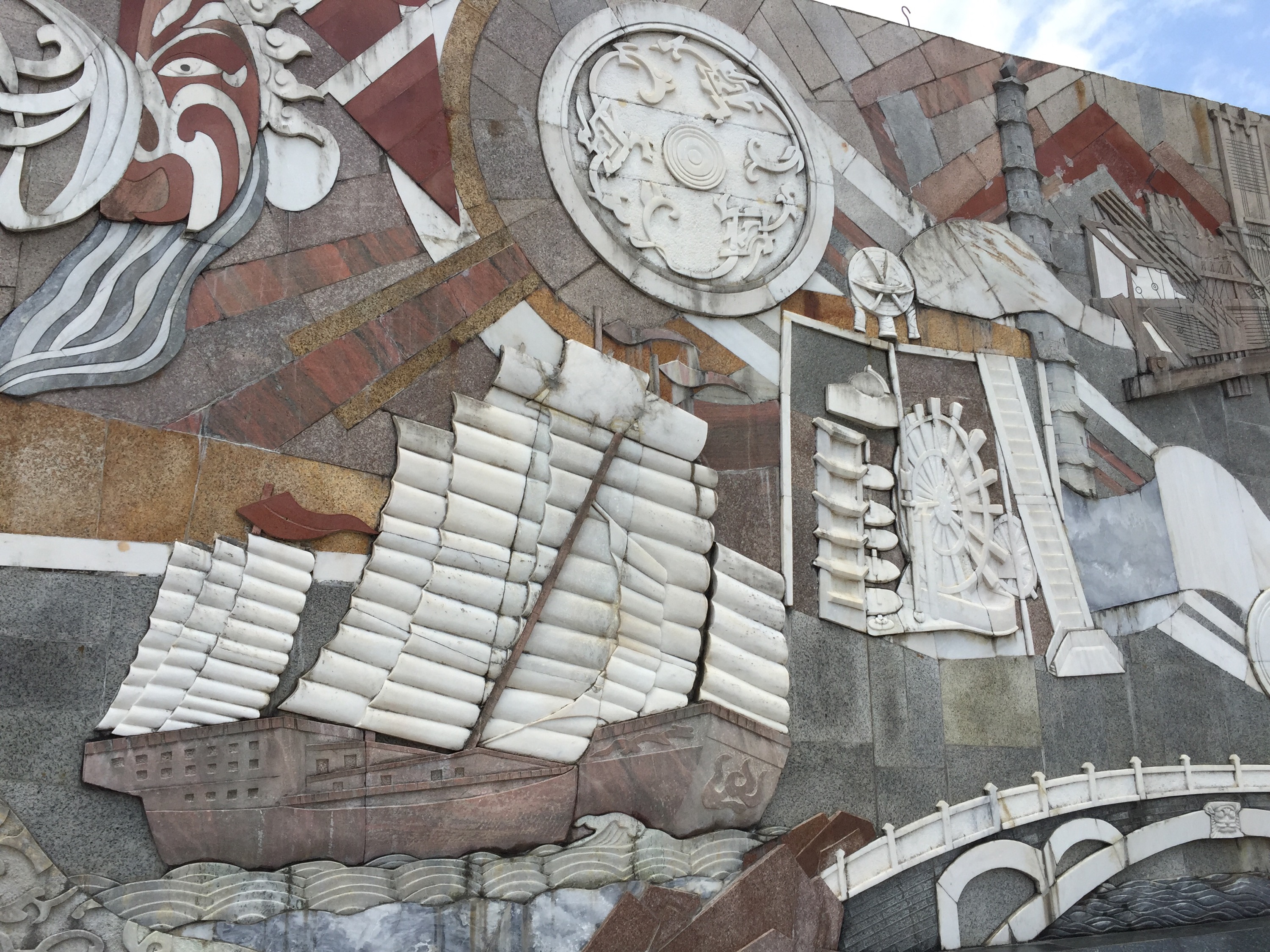 The invention of paper, and Chinese characters, also the constellations. In the centre right of this picture is an urn with dragons heads hanging off the top, each dragon head is holding a marble – this was an early earthquake warning system. If a tremor was felt, the dragon would drop his marble and it would show which direction the eathquake was coming from.
The invention of paper, and Chinese characters, also the constellations. In the centre right of this picture is an urn with dragons heads hanging off the top, each dragon head is holding a marble – this was an early earthquake warning system. If a tremor was felt, the dragon would drop his marble and it would show which direction the eathquake was coming from.  The pillar at the Forbidden City, depicting the symbols of the Emperor and the Hau animal that protected the Imperial Family..
The pillar at the Forbidden City, depicting the symbols of the Emperor and the Hau animal that protected the Imperial Family..
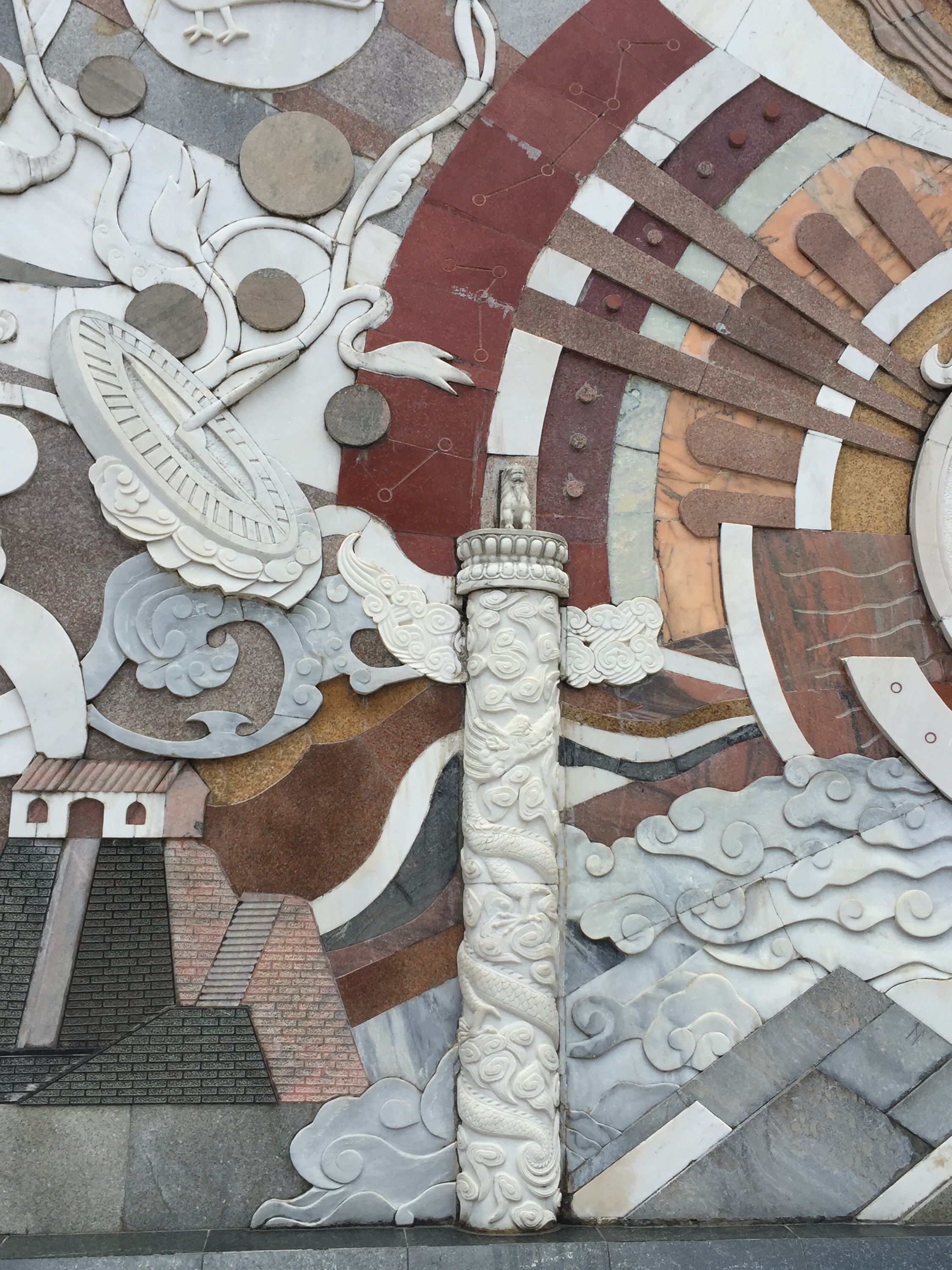 Buddha showing that Buddhism came to China 1800 years ago. Taoist symbols to represent the balance of the universe.
Buddha showing that Buddhism came to China 1800 years ago. Taoist symbols to represent the balance of the universe.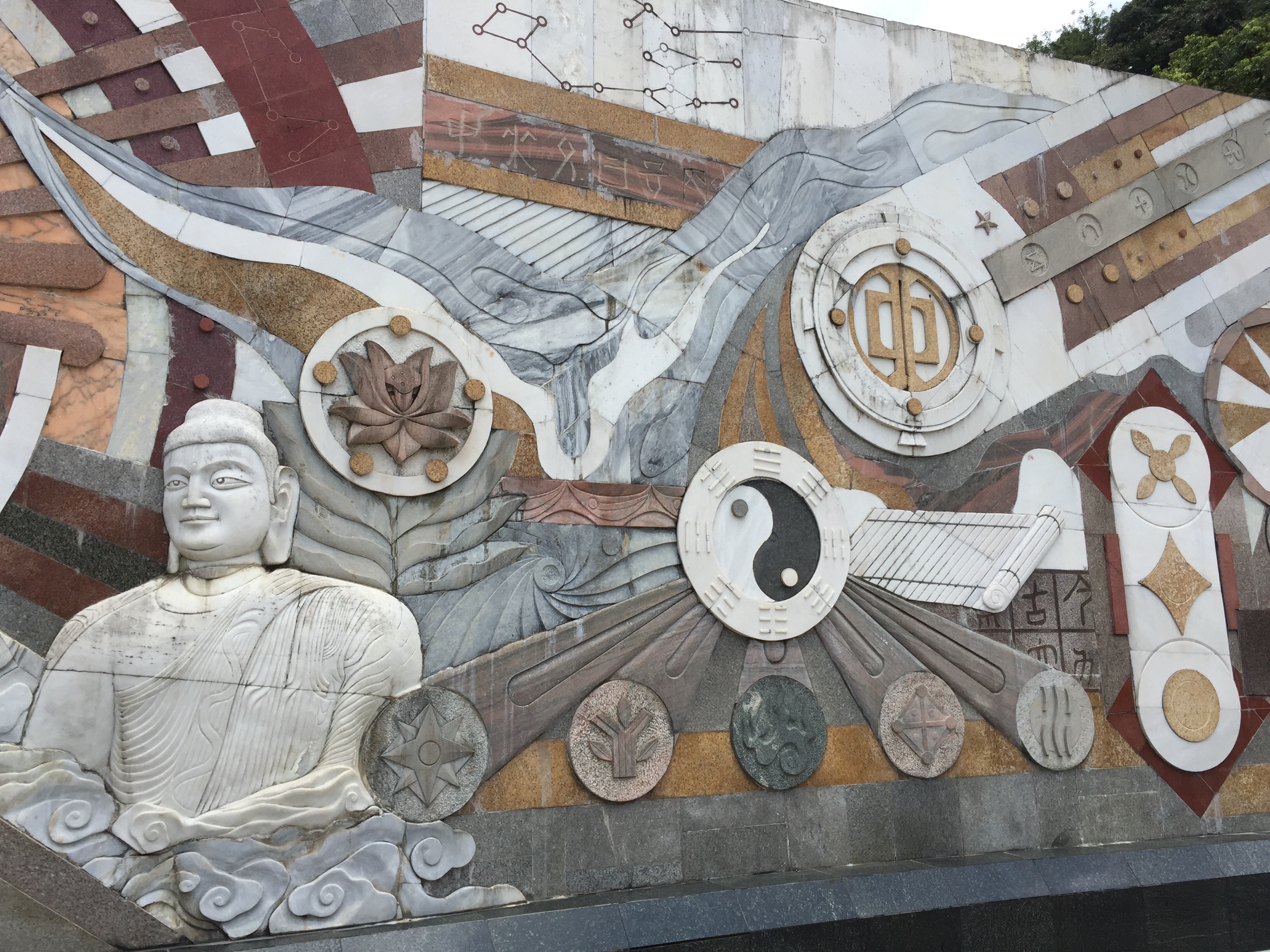
The building of the Great Wall of China, and the construction of the Heavenly pagodas.
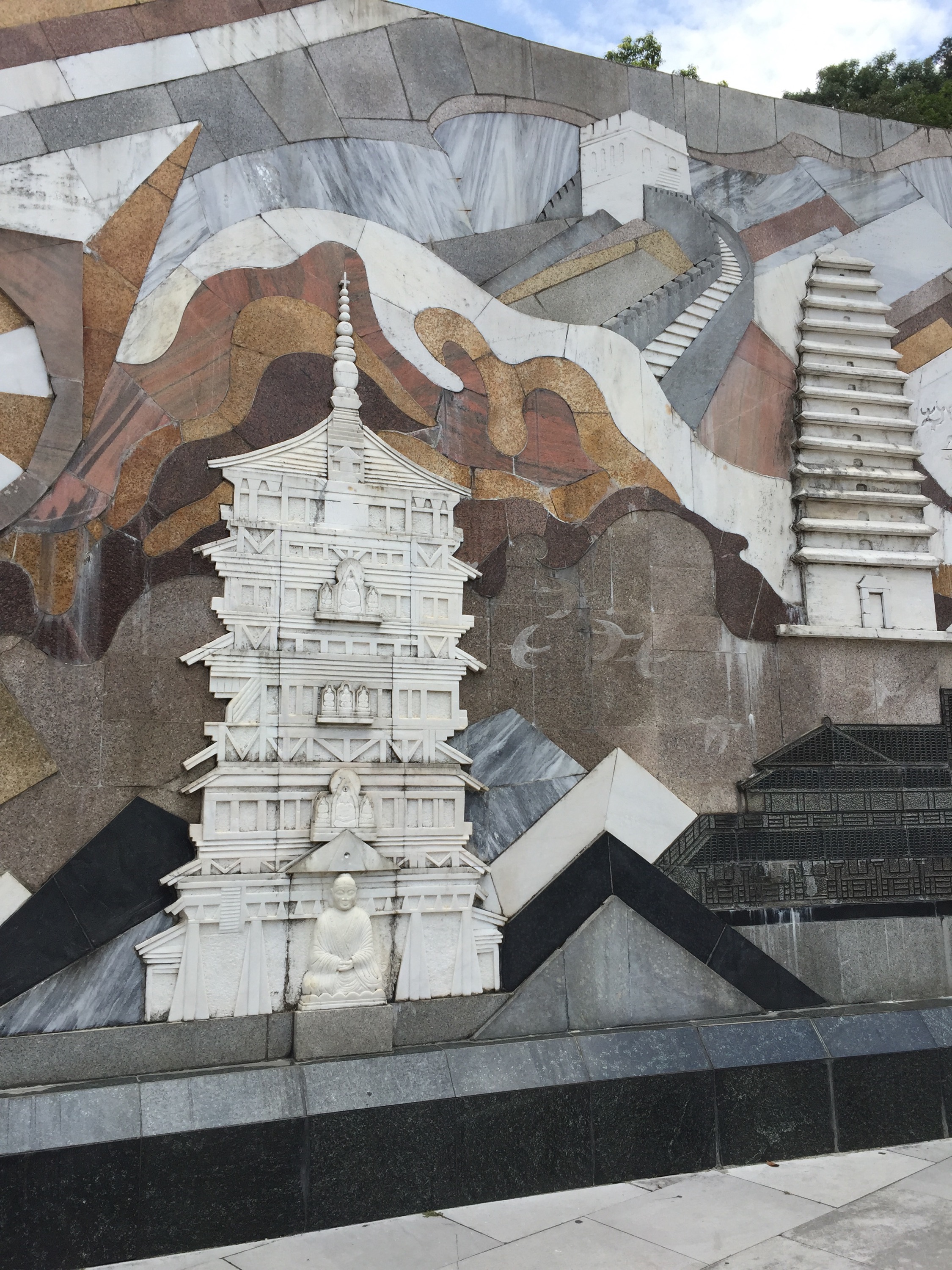
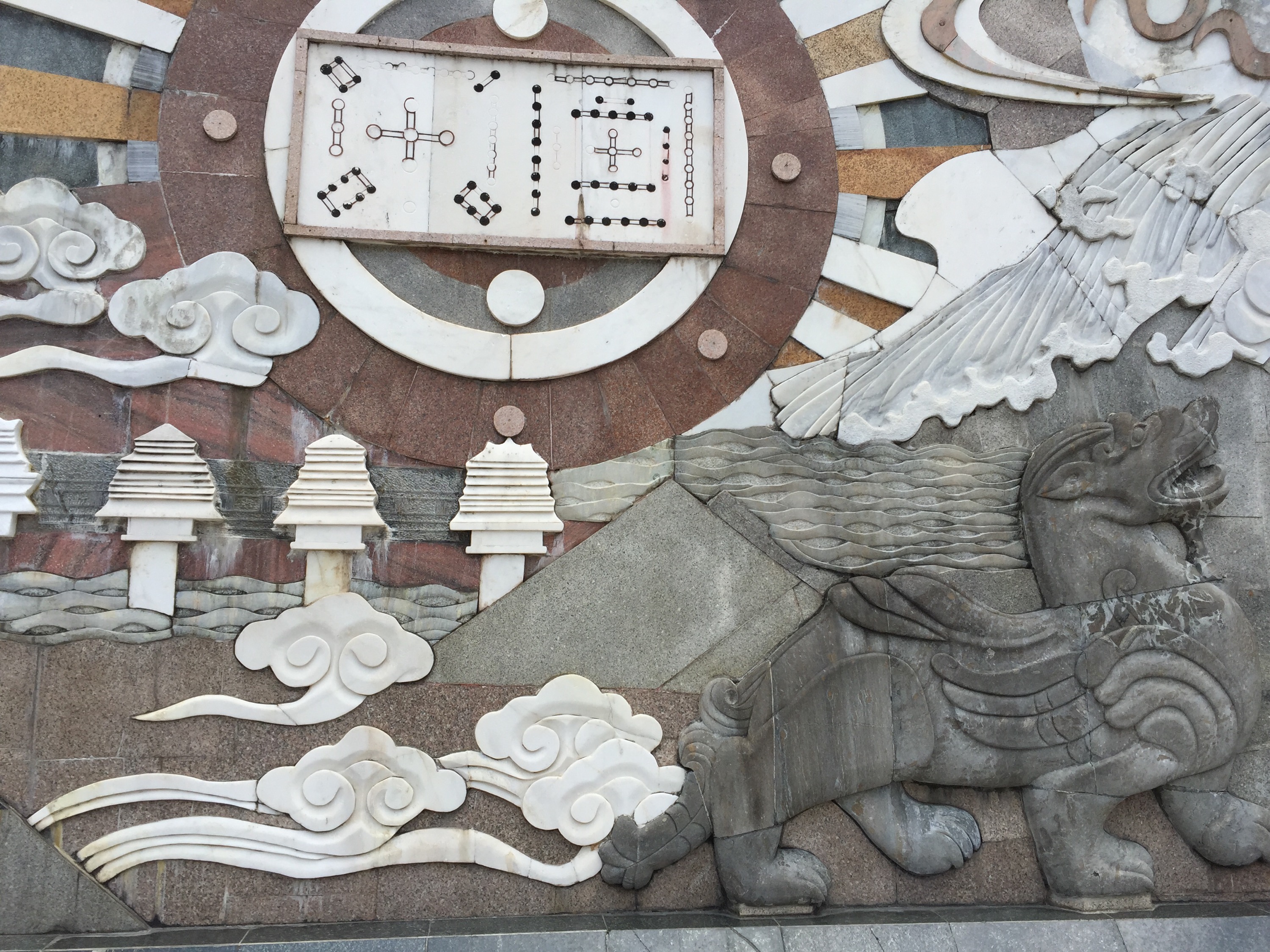 The Terracotta Army and a flying horse which represents ‘tourist’s in China (not sure why, she didn’t elaborate on that one).
The Terracotta Army and a flying horse which represents ‘tourist’s in China (not sure why, she didn’t elaborate on that one).
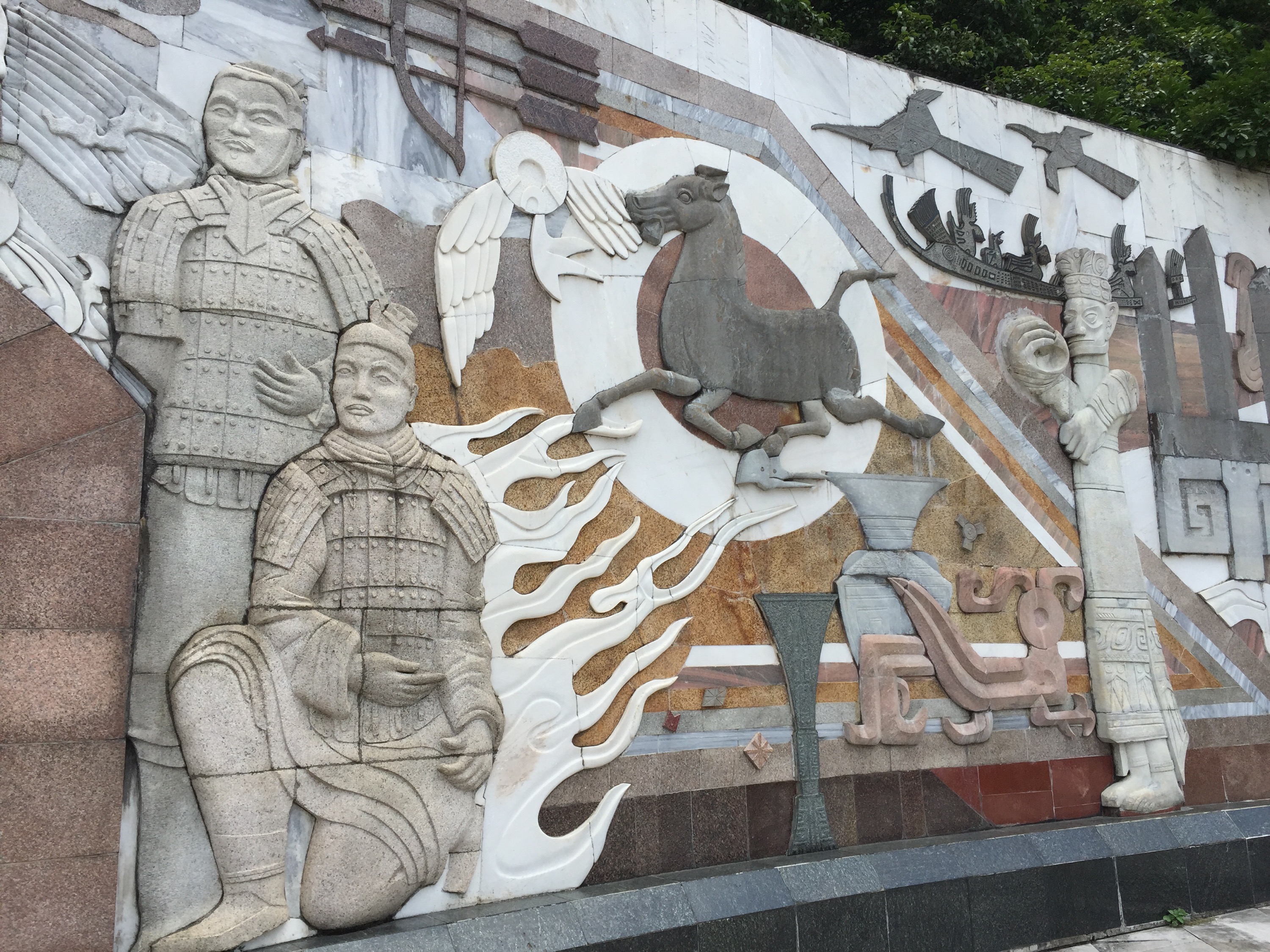 It is a very impressive piece of mixed stonework, probably about 70m long.
It is a very impressive piece of mixed stonework, probably about 70m long.  The Seven Star Park is also home to many wild monkeys, and there are many many warnings telling people not to interact with them, as they are not very friendly, and potentially not very clean. But apparently people insist on feeding them anyway.
The Seven Star Park is also home to many wild monkeys, and there are many many warnings telling people not to interact with them, as they are not very friendly, and potentially not very clean. But apparently people insist on feeding them anyway.

 Lovely lakes and cool spots to enjoy the park – somewhere for everyone, many people had their own hammocks up for the day, or were out in little rentable boats, or were jumping around in the inflatable pools etc that were up for the summer holidays.
Lovely lakes and cool spots to enjoy the park – somewhere for everyone, many people had their own hammocks up for the day, or were out in little rentable boats, or were jumping around in the inflatable pools etc that were up for the summer holidays.

 Also inside the park is Camel Hill – so call because, well… hello? Apparently Bill Clinton made a large speech on this site about the importance of protecting the environment, so it has become another very famous spot.
Also inside the park is Camel Hill – so call because, well… hello? Apparently Bill Clinton made a large speech on this site about the importance of protecting the environment, so it has become another very famous spot.

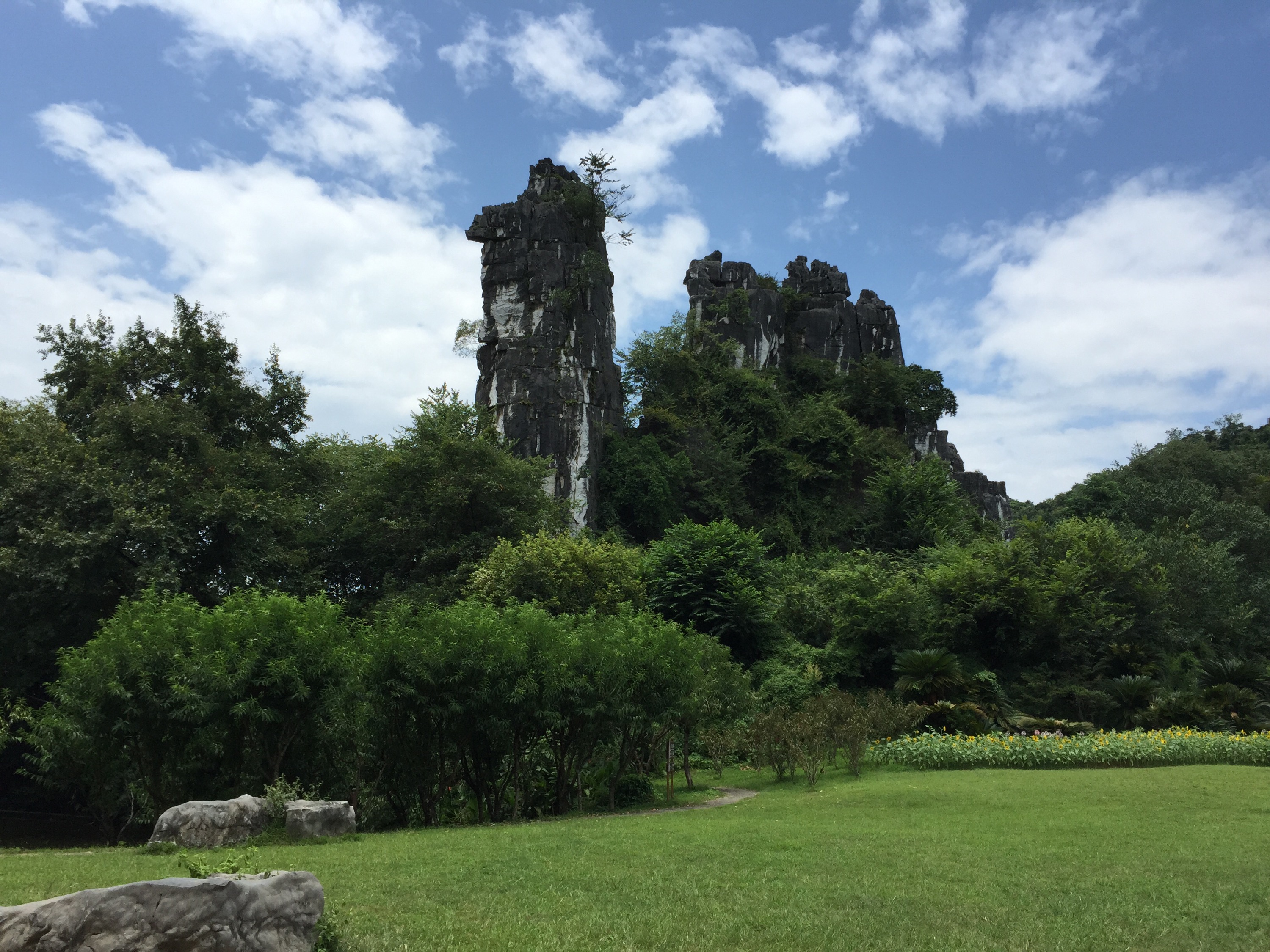
Then, a late lunch and crashing back at the hotel. We need to recharge before we hit the rivers tomorrow, and the Yangtze River Cruise later in the week.
